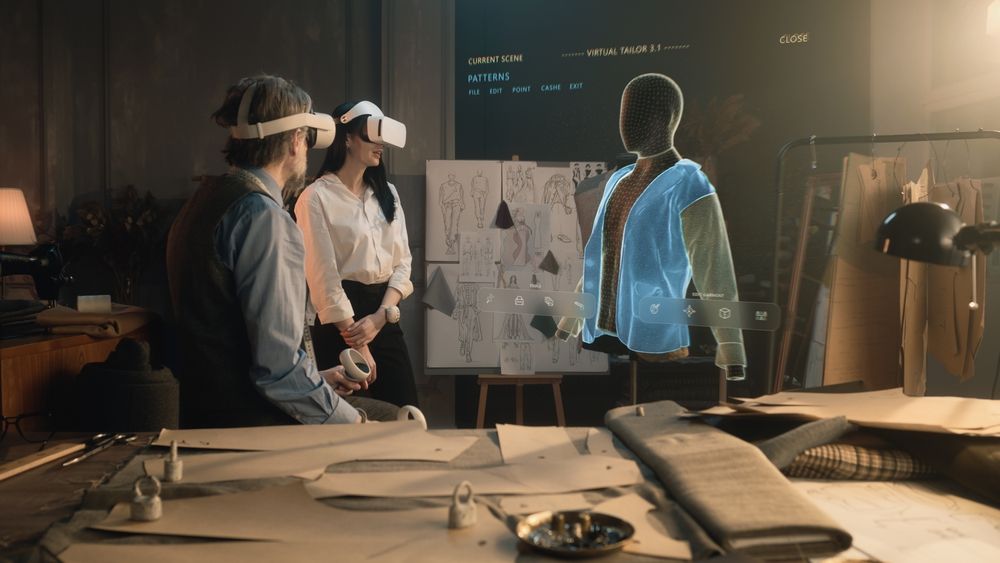How Technology Is Changing Fashion Retail

Retail technology has rapidly evolved over the past decade, reshaping how consumers interact with brands and experience shopping. From virtual fitting rooms to automated checkouts, retailers are increasingly adopting cutting-edge technologies to streamline operations, enhance customer experiences, and remain competitive in a fast-paced digital world. This article delves into some of the most significant retail tech trends currently shaping the industry and explores their implications for both consumers and businesses.
Virtual Fitting Rooms
The challenge of trying on clothes without physically visiting a store has been a significant barrier for online shopping. Virtual fitting rooms, however, are revolutionising how consumers shop for apparel online, bridging the gap between physical and digital retail experiences. The global market for virtual fitting rooms reached approximately $6.24 billion USD in 2023, this highlights the growing demand for innovative solutions that enhance the online shopping experience.
How It Works
Virtual fitting rooms leverage augmented reality (AR) and 3D technology to allow customers to see how clothes will look and fit on their bodies without trying them on in person. Shoppers can upload their measurements, or even a 3D scan of their body, and then virtually "try on" different outfits. Some systems use AR overlays on live video, where the user can see a realtime reflection of themselves wearing different clothes, much like looking into a mirror.
Benefits for Consumers and Retailers
For consumers, virtual fitting rooms reduce the uncertainty of online shopping, leading to more confident purchases and fewer returns. They also offer the convenience of trying on multiple outfits without the hassle of changing rooms.
For retailers, this technology can significantly decrease return rates, which have long been a costly issue in ecommerce. Moreover, virtual fitting rooms can enhance customer engagement by offering a more personalised shopping experience. Brands can also collect valuable data on customer preferences and behaviours, enabling them to tailor marketing strategies and inventory management more effectively.
Challenges and Future Outlook
While virtual fitting rooms hold immense potential, there are challenges to widespread adoption. These include the accuracy of the technology, user privacy concerns, and the need for high-quality, detailed 3D models of clothing items.
However, as AR technology continues to advance and become more accessible, the adoption of virtual fitting rooms is expected to grow. The future could see a seamless integration of virtual and physical retail experiences, where customers could try on clothes virtually instore or even from the comfort of their homes.

Automated Checkouts
The days of waiting in long checkout lines may soon be a thing of the past, thanks to automated checkout technologies. These systems aim to streamline the payment process, making it faster, more efficient, and less reliant on human cashiers.
Types of Automated Checkout Systems
- Self Checkout Kiosks: These have been a familiar sight in supermarkets and retail stores for years. Customers scan their items, bag them, and pay using a card or mobile payment system. While convenient, these systems often require staff assistance and can suffer from issues like incorrect scanning or technical glitches.
- Mobile Checkout Apps: Mobile apps that allow customers to scan items as they shop and pay directly through the app are becoming increasingly popular. These apps can significantly reduce checkout times and provide a more personalised shopping experience.
- Just Walk Out Technology: Pioneered by Amazon Go stores, this technology allows customers to enter a store, pick up items, and leave without going through a traditional checkout process. Sensors and cameras track what customers take, and their Amazon accounts are automatically charged. This system offers the ultimate convenience and a frictionless shopping experience.
Benefits for Retailers and Consumers
Automated checkouts can reduce labour costs, speed up the checkout process, and enhance customer satisfaction by eliminating long lines. They also allow retailers to reallocate staff to other tasks that require a human touch, such as customer service or restocking shelves.
For consumers, the primary benefit is convenience. Automated checkouts can make shopping faster and more efficient, particularly in smaller stores where just walk out technology can completely eliminate the need to interact with a cashier.
Challenges and Considerations
The implementation of automated checkouts is not without its challenges. High upfront costs, technical issues, and the potential for theft are significant concerns for retailers. Moreover, the shift towards automation raises questions about the future of retail jobs, particularly for those whose roles may be replaced by machines.
Despite these challenges, the trend toward automation is likely to continue, driven by consumer demand for convenience and the potential cost savings for retailers.
Artificial Intelligence (AI) in Retail
AI is rapidly becoming a cornerstone of modern retail, with applications ranging from personalised recommendations to inventory management. AI's ability to process vast amounts of data and learn from it enables retailers to offer more personalised, efficient and effective services.
Personalised Shopping Experiences
One of the most visible applications of AI in retail is personalised recommendations. Ecommerce giants like Amazon and Netflix have long used AI algorithms to suggest products and content based on users' past behaviours and preferences. This personalisation can significantly increase conversion rates and enhance customer loyalty.
AI driven chatbots and virtual assistants are also becoming more sophisticated, providing customers with realtime assistance and personalised shopping experiences. These AI tools can answer questions, guide users through the purchasing process, and even offer style advice or product recommendations.
Inventory Management and Supply Chain Optimisation
AI is also transforming inventory management by predicting demand more accurately and optimising stock levels. Machine learning algorithms analyse historical sales data, current trends, and external factors like weather or holidays to forecast demand. This enables retailers to maintain optimal inventory levels, reducing the costs associated with overstocking or stockouts.
In supply chain management, AI can help optimise routes, reduce shipping times, and even predict potential disruptions. This level of efficiency is particularly crucial in today's fast-paced retail environment, where customers expect rapid delivery and seamless service.
AI Powered Pricing Strategies
Dynamic pricing, where prices fluctuate based on demand, competition, and other factors, is another area where AI is making a significant impact. Retailers can use AI to adjust prices in realtime, maximising profits while remaining competitive. This technology is particularly useful during peak shopping periods, such as Black Friday, where demand can change rapidly.

Augmented Reality (AR) and Virtual Reality (VR)
Beyond virtual fitting rooms, AR and VR technologies are finding a wide range of applications in the retail sector. These immersive technologies can create engaging, interactive shopping experiences that go beyond the capabilities of traditional online or instore shopping.
Virtual Stores and Showrooms
AR and VR can be used to create virtual stores or showrooms where customers can explore products in a 3D environment. These virtual spaces can mimic the layout of a physical store, allowing customers to browse, interact with products, and make purchases as if they were there in person.
Luxury brands and high-end retailers are particularly interested in this technology, as it allows them to offer an exclusive shopping experience to customers who may not be able to visit a physical store.
Product Visualisation
AR can also be used to visualise products in a customer's home before they make a purchase. For example, IKEA's AR app allows users to see how furniture will look in their living space by overlaying a 3D model of the item onto a live view of their room. This can reduce the uncertainty of online purchases, particularly for larger items like furniture, and lead to more confident buying decisions.
Interactive Marketing and Advertising
AR is increasingly being used in marketing and advertising to create interactive, engaging campaigns. For instance, cosmetic brands have developed AR apps that allow users to try on makeup virtually, while automotive companies use AR to let potential buyers explore the features of a new car in detail.
These interactive experiences can significantly enhance brand engagement and are particularly appealing to younger, tech-savvy consumers.
Omnichannel Retailing
The lines between online and offline shopping continue to blur, giving rise to omnichannel retailing a strategy that provides customers with a seamless shopping experience across multiple channels, whether they're shopping online, in a physical store, or through a mobile app.
The Importance of Integration
Successful omnichannel retailing requires a high level of integration between a retailer's various channels. Inventory systems, customer data, and marketing strategies must all be aligned to ensure that customers have a consistent experience, regardless of how they choose to shop.
For example, a customer might research a product online, check its availability at a nearby store, and then purchase it using a mobile app for instore pickup. The ability to move seamlessly between channels is crucial to meeting the expectations of modern consumers.
Omnichannel Loyalty Programs
Retailers are increasingly developing loyalty programs that work across all channels, rewarding customers for their engagement both online and offline. These programs often use AI to personalise offers and rewards based on a customer's shopping habits, further enhancing the omnichannel experience.
Challenges and Opportunities
Implementing an omnichannel strategy can be complex, requiring significant investment in technology and infrastructure. Retailers must also ensure that their staff are trained to manage multiple channels and provide a consistent level of service.
However, the benefits of omnichannel retailing are substantial. By offering a seamless shopping experience, retailers can increase customer satisfaction, drive sales, and build stronger brand loyalty.
Sustainability and Ethical Retailing
As consumers become more aware of environmental and ethical issues, retailers are increasingly adopting sustainable practices and technologies. This trend is not only driven by consumer demand but also by the recognition that sustainability can be a competitive advantage.
Sustainable Supply Chains
Retailers are using technology to make their supply chains more sustainable. This includes everything from sourcing materials responsibly to reducing waste and carbon emissions. AI and blockchain technology are playing a significant role in this area, providing greater transparency and enabling retailers to track the environmental impact of their products.
Second Hand and Circular Retail Models
The rise of secondhand and circular retail models, where products are reused, refurbished, or recycled, is another trend driven by sustainability. Online platforms like ThredUp and Poshmark have popularised secondhand shopping, while major retailers like Patagonia have embraced circular models, offering repair services and resale programs.
Ethical Shopping and Transparency
Consumers are increasingly seeking out brands that align with their values, leading to a rise in ethical shopping. Retailers are responding by being more transparent about their sourcing, labour practices, and environmental impact. Technology plays a crucial role in this transparency, enabling consumers to access detailed information about the products they buy.
As retailers continue to innovate and adopt these technologies, the shopping experience will become more personalised, convenient, and sustainable. However, these changes also present challenges, particularly in terms of cost, implementation, and the impact on jobs. Retailers who can navigate these challenges and leverage technology effectively will be well positioned to thrive in the increasingly competitive retail landscape.
The future of retail lies in the seamless integration of technology into every aspect of the shopping experience, creating a world where consumers can shop how, when, and where they want with greater convenience, personalisation and sustainability than ever before.
At Pure London x JATC we’re inviting industry leaders, innovators and professionals to contribute to our blog.
Share your thoughts on the latest industry trends, challenges and opportunities. This is your chance to influence the conversation among the retail industry. Ready to contribute? Let’s collaborate.
Got valuable knowledge to offer? Let’s start the conversation—submit your ideas today!
